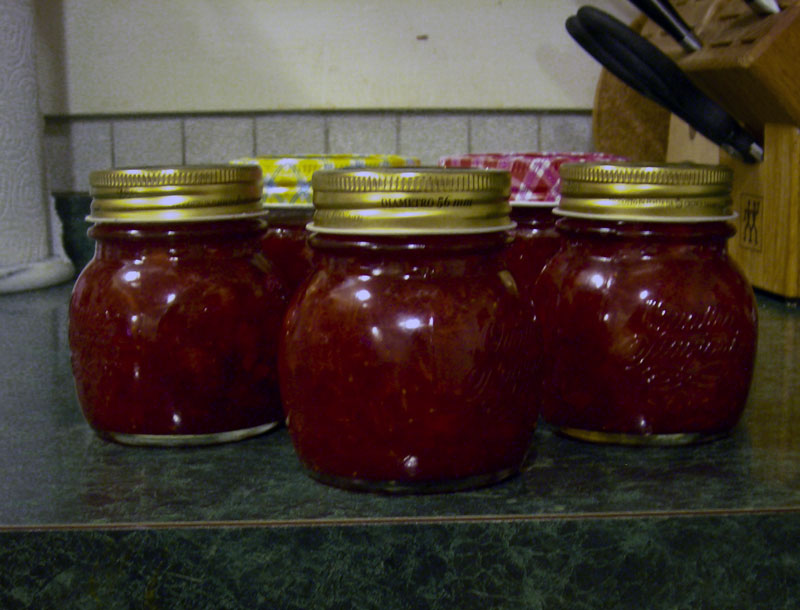Did you know there’s currently a glut of strawberries on the market in the United States? Florida’s strawberry crop was delayed by cold and it has produced not only an overabundance of crop, but this year it also coincided with California’s peak. This means strawberry farmers have lots to sell at at a lower price per unit than usual. Strawberries are rarely cheap, but they’re cheaper than usual right now. This isn’t local produce for most of us, but these farmers do need to sell their crops, and I for one am happy to help them do just that.
Of course, unless you preserve them in some way, you can’t eat them year-round, and while it seems impossible for those of us who love strawberries to have too much, it is possible.
An easy way to preserve strawberries is with freezer jam. What’s freezer jam and how do you make it? Freezer jam is regular fruit jam that you store in the freezer rather than can and put on a shelf. It also couldn’t be much easier to make.
What you’ll need (and change proportions as necessary):
– 4 cups of mashed strawberries (measure after you mash)
– 2-3 cups of sugar, or use the proportionate amount of sugar substitute such as honey if you prefer
– 3/4 cup water
– about 1oz low sugar pectin
Mash the strawberries. I used a potato masher. Behold the strawberry carnage:
My apologies to younger and/or more sensitive viewers.
Add the sugar to the strawberries, stir for a few minutes, then let them sit for 10 minutes. In a small saucepan, bring your water to a boil, mix in the pectin, and let it boil for 1-2 minutes. Pour the water mixture into the bowl with the strawberries and stir with a whisk until it starts to form a gel. It won’t be as thick as regular cooked jam, by the way. Place it in glass jars or other containers that are freezer-ready:
I planned to use some jars from relish as those were what I had, but even after a cycle in the dishwasher, the caps at least still smelled like relish. Next time I have less stinky jars, I’ll use those. For now, however, I used canning jars.
Then, leave them out for 24 hours and store what you’re using right away in the fridge and the rest in the freezer. It should keep for a year in the freezer and for about a week in the fridge. You can use this as topping for ice cream, on toast or muffins, or as a substitute for syrup on pancakes.
This recipe was based on the Sure-Jell pectin package instructions, but if you buy a different kind, I recommend using their instructions instead. Also, I’m going to remove some of the jam from these so that the level is below the shoulder. I don’t have small straight jars, and Ball recommends that you not use ones with “shoulders”, as they can crack when the liquid inside expands as it freezes.
What else can you do with strawberries, besides eat them straight? You can make one of my favorite treats.
These are strawberries with balsamic vinegar from Oak Park’s farmer’s market, black pepper, and homemade whipped cream. If you’ve never eaten strawberries this way, I’m sure putting balsamic vinegar and pepper on them sounds really odd, but trust me when I say it’s delicious. The acidity of the vinegar truly brings out the sweetness and flavor of the strawberries, and as a bonus, balsamic vinegar keeps almost forever. For a less sweet version, you can substitute crème fraiche.
How do you make homemade whipped cream? That’s even easier than freezer jam.
What you’ll need (and as always, change amounts but keep proportions as necessary):
– 2 cups of whipping cream, which is about what you get out of a half-pint
– 3 tablespoons of sugar
– 1 tsp of vanilla extract
You can do this one of two ways. You can beat the cream on high with an electric mixer until it thickens and then mix in the sugar and vanilla, or you can add everything to the bowl at once and mix with the mixer on high. I make it with the latter method and it still turns out delicious. It doesn’t keep very long in the fridge, probably 3 days at the maximum, so be sure to use it quickly.
Happy eating, everyone.








Pingback: It’s strawberry season! Preserving strawberries | Green In Oak Park
Pingback: Preserving blueberries | Green In Oak Park